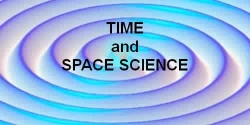Tektites (Australites)
Tektites (Australites)

Tektites are small, black blobs that might pass for hardened bits of asphalt but they are actually walnut-sized glassy stones. They commonly take on distinctive regular shapes like teardrops, dumbbells, and strangely flanged buttons that look like the tops of large rivets with the stems melted off. They're called tektites, and they are found strewn about on the ground in widely separated "fields" around the world, the largest of which covers most of Australia.
Where did they come from?
A Very Rare Event!
Age Paradox
Another Tektite Fall in
Australia?
Fresh Falls?
Distribution
'Parent Body' Theory Revisited!
Arguments for terrestrial
origin
Arguments against
terrestrial origin
Characteristics of Tektites
References
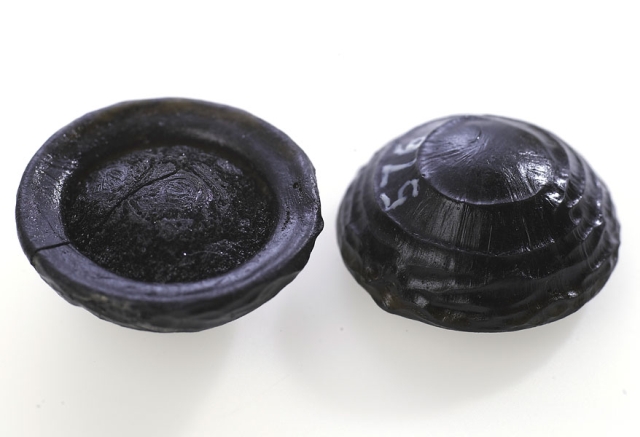
The one thing on which most scientists can agree about tektites is the way in which they obtained their shapes. Flow structures seen on tektites examined under the microscope tell of a very fast trip through the atmosphere while they were still molten. The flanged lip of the rivet-head type was formed by air forcing the molten glass from the nose back around the outer edges where it solidified while the tektite was still in flight. The dumbbell types were created when the molten mass was spinning like a majorette's baton, forcing material to the ends. If the connecting rod broke, the end result was two teardrop-shaped pieces, which then flew away from each other. Intermediate stages shaped like disks or rods are also found. The earliest written reference to tektites was made in 1787, when it was thought that they were a special kind of obsidian, or volcanic glass (it was also suggested that they might be the product of some prehistoric glass factory). After all the intervening years of study, there is still disagreement as to their true origin.

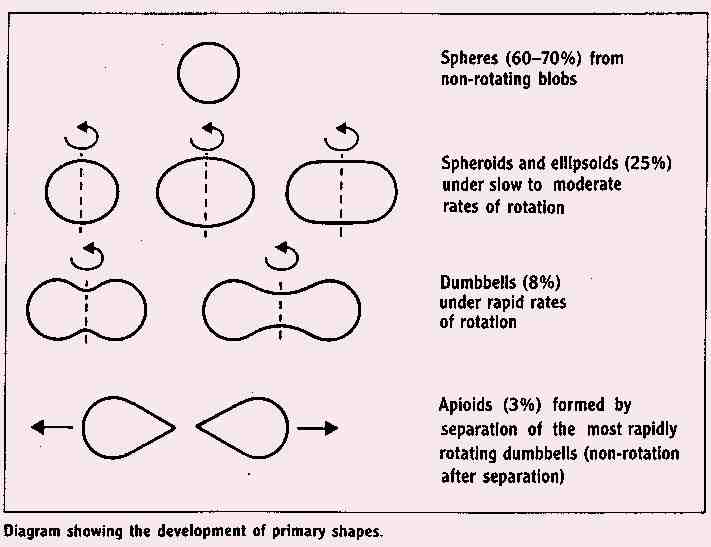
Because the chemical composition of most tektites is so similar to that of the earth's crustal rocks, early theories that they may be true meteorites can almost certainly be rejected. However, it seems almost essential to include an "extraterrestrial connection" in explaining their formation.
One of the more durable theories about the origin of tektites is that they were formed from molten blobs that were splashed away from the site of impact when a meteorite struck the earth. Unfortunately for this theory, appropriate impact craters cannot be found to account for all the earth's tektite fields.
Another theory is that the meteorite impacts occurred on the moon and that tektites are droplets of rock that splashed off the moon onto the earth. Still other researchers insist that they have been propelled from the moon to the earth by titanic eruptions of lunar volcanoes that formed the mares, the stony seas of the moon. (Most astronomers strongly disagree with this, holding that these large, flat areas on the moon's surface were created by the impacts of large meteorites, with lava from the moon's interior filling the craters).
In the last few years, it has been learned that some of the meteorites found on earth are almost certainly fragments of Mars, but where tektites come from is still an unresolved question. Tektites also come in unusual, less common forms:
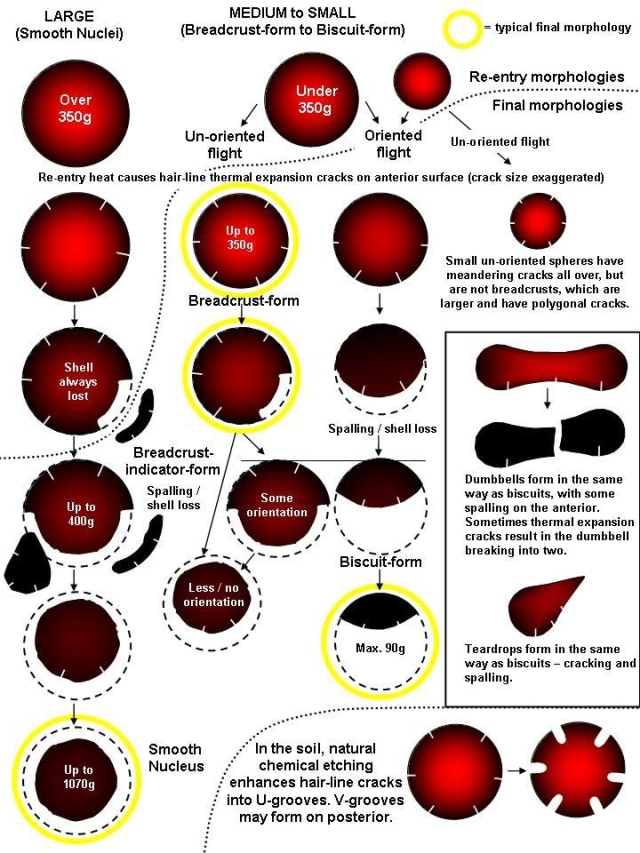
Where did they come from?
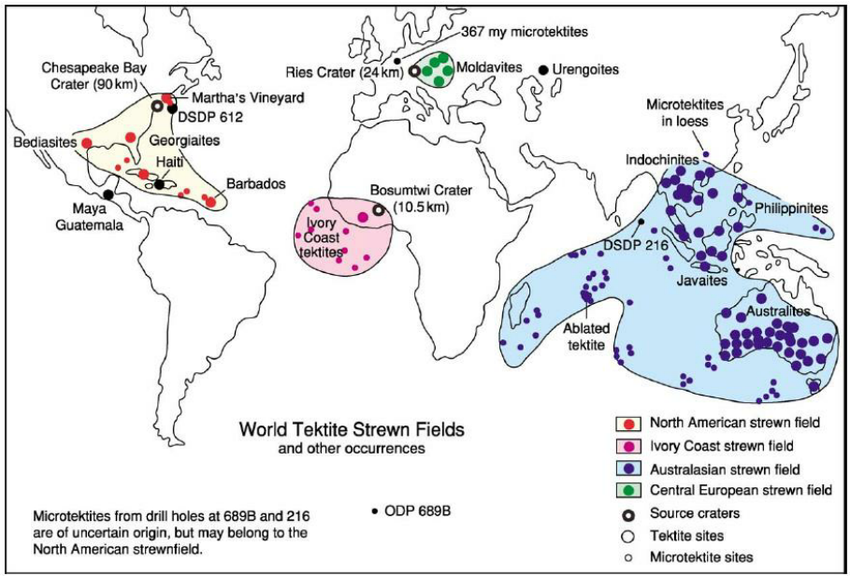
Everybody agrees that the australites entered (or re-entered) the earths atmosphere at a high velocity and this is the cause of the secondary melting seen on the shapes. No other tektite shows this secondary melting with the exception of some intermediate Javanites.
The accepted theory is that an asteroid or comet entered the earths atmosphere at an acute angle (had to be less than 10') and hit the ground somewhere near Cambodia with such force that a huge quantity of the earths crust was melted and some was thrown out of the atmosphere, this then travelled thousands of kms and re-entered at velocities of 11km/sec or less over Australia forming the aerodynamically ablated australites.
Material which did not make it out of the atmosphere fell over S.E.Asia to form the typical 'splash-form' Asian tektites and puddles of molten glass which hardly left the ground are thought to have formed the large Muong Nong layered tektites found close to the impact site. However, there has still not been an impact crater found to support this theory.
Other theories of origin, especially those of arriving from outer space have been dismissed because the tektites do not show evidence of having been in space for very long and the theory of a lunar origin has been dismissed for many reasons .
Extensive analysis of the tektites from Asia and Australia suggests a common origin, and dating techniques also suggest one event about 700,000 years ago. There have been literally hundreds of papers written on chemical analysis trying to prove a link to a terrestrial origin but very little can be found on the mechanism of distribution.
Although most of the evidence points to a terrestrial impact in Indochina creating the whole of the Australasian strewn field there are still many unexplained problems with this theory.
I realise that I am not a geophysicist and can only quote theories from papers I have read but I have tried to understand the whole phenomena including the real evidence of the tektite distribution. I will put forward my own ideas here and I welcome an open debate.
A Very Rare Event!
When you consider the long history of the earth it is incredible that no other similar impact occurred which threw debris into space with a subsequent fall back through the earths atmosphere to create aerodynamically shaped tektites. The scientists argue that no other similar strewn field has been found simply because the tektites would not have survived long periods of erosion (yet they have supposedly survived 700,000 years in remarkable condition! and what about the ones found in Australia that date at 4 million years!). The mechanism for getting millions of these small molten blobs out of the atmosphere and across huge distances of space at such high velocities, has not been explained. One explanation suggests a rarefied gap in the atmosphere was created by the asteroid or comet as it plunged to earth, temporarily opening up a hole behind it for debris to exit through. But would this hole have allowed 'rays' of debris to fan out sideways to the Philippines on one side and the Indian Ocean on the other side (where a flanged button was found) as well as towards Australia? What about tektites reported to be found in Tibet?
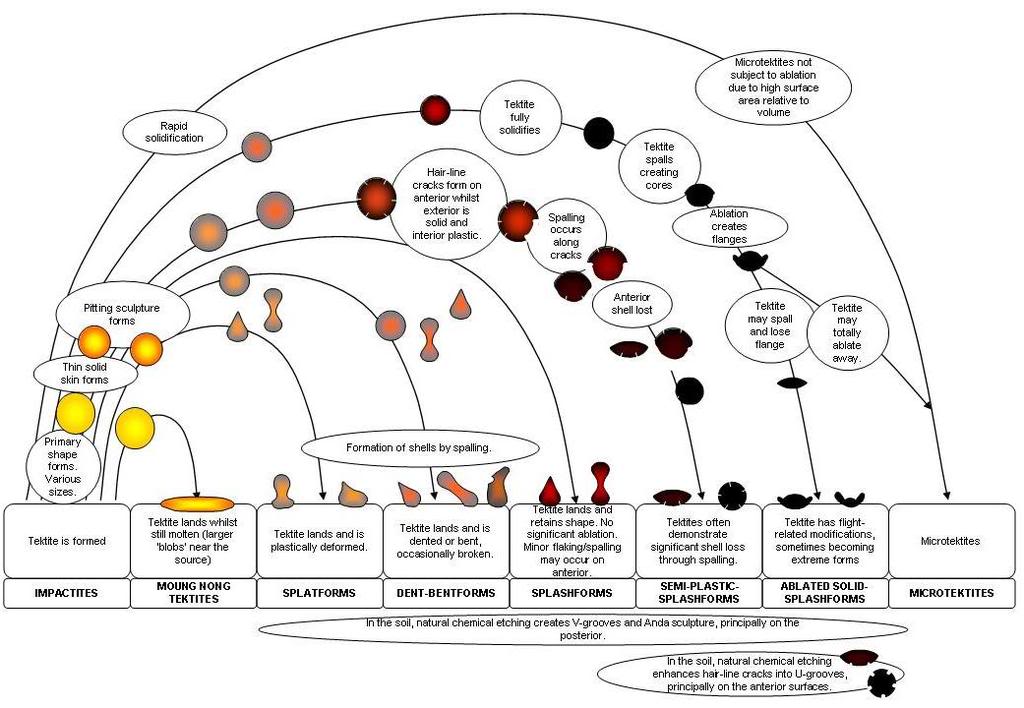
Age Paradox
Australites have been dated at 700,000 years by two radiometric dating methods - fission track and potassium-argon (K-Ar).
Geologists however, from first hand field observations, place the fall at a much younger age.
It is generally accepted though that the australites have not travelled far from where they landed and that the ones found on the surface in good condition have only recently been eroded out of certain 'paleosols'. These paleosols seem to be a lot younger than they should be if it is assumed that the tektites originally fell onto them. The easy solution is to suggest that the tektites originally fell into older sediments but have since been washed out into these younger sediments! This improbable 'redeposition' has supposedly taken place over huge, widely separated areas in Australia and also in other tektite localities around the world! There is obviously something wrong with either the dating of the age of the tektites or the dating of the paleosols they are found in. The dating of the flanges of buttons is similar to the dating of the primary body so it cannot be suggested that they were created at one time but fell only recently.
*(1) Lovering, Mason, Williams and McColl in their paper titled 'Stratigraphical Evidence for the terrestrial Age of Australites' found strong evidence pointing to australites having been deposited into relict sand dunes called the Motpena Paleosol on the Lake Torrens Plain. Numerous samples of this paleosol were dated using the radiocarbon method at being between 24,000 and 16,000 years old. The nearest older deposits were 15 to 25 km away and it was inconceivable that the many delicately shaped fragile australites could have been transported that far without abrasion. They also found 200 m of Quaternary deposits beneath the Motpena strewn field. If the australites had fallen onto the plain in the early Pleistocene (about 700.000 years ago), they would by now be deeply buried within the Quaternary deposits. In fact there was clear evidence that the tektites were eroding out of the relic sand dunes and being incorporated in alluvial and aeolian deposits of mid - Holocene age in the interdune corridors.
*(2) The Smithsonian study which was published in 1976 has an even stronger case for the young age of australite fall.
The report concludes that:"No one who has seen the Port Cambell localities and examined the many perfectly preserved australites therefrom is likely to argue that these specimens are not being found essentially where they fell. The complete lack of solution etching , even on thin plates weighing as little as 0.03 gram, is a powerful argument against the australites having been subjected to terrestrial weathering, even in situ, for more than a few thousand years"
*(3) In 1973 W.H.Cleverly of the School of Mines Kalgoorlie wrote about a patch of extremely well preserved tektites found near Kalgoorlie, many of which were of the rare, fragile form:
'It is still difficult to believe that small australites could have remained in such an area for the hundreds of thousands of years of 'age on earth' required by some authors; indeed, during even the modest periods of the order of one to tens of thousands of years advocated by the other school of thought, their situation must have been precarious.'
It seems that most Australian geologists, who see the australites in situ, find it very hard to believe the entire age of fall to have been 700,000 years ago and it would seem that no matter how much stratigraphical evidence is produced for a younger age, it would be dismissed as being wrong!
The earlier noted scientists such as Charles Fenner, George Baker and Edmund Gill who picked up pristine tektites from the arid surface of Australia, became convinced that the shower of tektites arrived recently.
More recently Izokh (1993) in Vietnam found the age of fall to be 10.000 years.
Another Tektite Fall in Australia?
A dozen australites high in sodium, were found in North West of South Australia which gave dates of 4 million years old. Very little mention is found of this group and it seems hard to believe that a different fall of aerodynamically shaped tektites (which are unique to Australia) should occur in the middle of the general strewn field. Could there have been some errors with the dating of these tektites? Why have there not been more found?
Fresh Falls?
There does not seem to be much in the way of authentic records of new tektite falls.
A fall was witnessed in Igast , Latvia in 1855 but I have no information on it.
There have been several reported sitings of 'fresh falls' in Australia but most are unconvincing.
The *(6)You Yang one in Victoria turned out to be a much abraded core which could not have just fallen. One explanation I can think of is that it was picked up somewhere by a very strong 'whirly wind' and later fell to earth again. This has happened with other objects.
*(7)One australite was reported as falling near Lake Grace Western Australia in 1934 by men working in a field. They heard a hissing noise and something flew past them like shrapnel hitting the ground with an audible thud. They found a hole in the ground about 12 inches deep with the australite at the bottom. It was a typical ellipsoidal australite weighing 31 grams with a brilliant fresh looking black surface, sculptured with many sharply defined grooves and pits. Unfortunately it was in the possession of Mrs G. Dewar who took it to Scotland to give to her brother.
*(8) Another convincing report was made of a fall in WA. in Cottesloe near Perth in 1935. A Mr. F. Hanson was working on a gravel tennis court when he heard a thud on the surface of the tennis court. He found evidence of something having penetrated the surface and dug down to find a tektite, it was still too hot to hold in the hand!
It was not until 1938 after showing it to numerous friends, that it was recognised as a tektite and handed to the West Australian Museum. It was a typical australite of specific gravity 2.42, 154 grams and lens shaped. It had the distinct equatorial rim. There was no sign of weathering or sand abrasion on the very fresh shiny surface which had many typical grooves, minute wrinkles and pits. See below images.
Only when such tektites are properly analysed and dated can a 'fresh fall' be authenticated.
I have heard of 'fresh looking' australites being found in places where they were not seen before and being coated in a red substance which easily washes off in the slightest dew leaving a red rim around the tektite on the ground. As the red substance has not been analysed or such tektites dated, the story can be considered only hear-say!
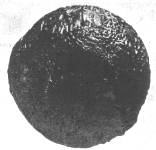 |
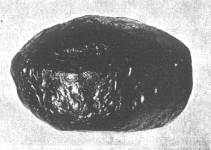 |
Australites seen to fall Cottesloe Perth Western Australia 1935 |
*(9)Kyotite
In 1993, an egg-shaped tektite like object landed on the 7th floor of a building in Kyoto City, Japan. The next day it was taken to the National Science museum and analysed. Internally it was found to resemble obsidian more than tektite. It had numerous globular-shaped, irregular hair-shaped, opaque crystallites and colourless microlites. The flow structure was different to a tektite. It also contained numerous magnetite grains accompanied by partly reduced metals. In fact it contained five different types of iron including metallic iron in a silicate matrix. It was found to be most similar chemically to terrestrial granite or lunar glasses but definitely had an extraterrestrial origin which was not too far from earth. They made some comparisons with tektites they obtained from the British Museum.
| kyotite |
australite | bediasite | inochinite | moldavite | wada pass | koshidake | shiratake | |
|---|---|---|---|---|---|---|---|---|
| SiO2 | 77.5 | 72.8 | 74.5 | 75.1 | 78.7 | 77.4 | 77.1 | 76.9 |
| AlO3 | 13.4 | 13.7 | 14.5 | 11.9 | 8.85 | 11.9 | 12.5 | 12.0 |
| FeO | 0.59 | 4.30 | 4.12 | 4.31 | 1.64 | 0.63 | 0.77 | 0.68 |
| Na2O | 3.53 | 0.83 | 1.52 | 0.90 | 0.28 | 3.36 | 3.35 | 3.23 |
Distribution
Bands of Distribution and Concentrated patches.
When you actually go searching for australites and start finding them (if you are very lucky!) you realise that they are actually not distributed evenly but tend to be found in sometimes very concentrated patches. Most of the dense patches have now gone but it was not uncommon in the past to come upon a small area of only a couple of acres which contained hundreds of tektites, yet identical surrounding country would have none at all!
Some of these patches could be due to erosional processes concentrating the tektites but in many cases the tektites are in too good a condition to have travelled far.
In some salt lakes the tektites are found only in certain places near the edge. Either water action or wave action combined with wind has concentrated them up to one end of the lake (like shells on a beach), or they are eroding out of old soils on the edge of the lake.
From my own observations it seems that they are eroding out of ancient sand dunes along the edges of the lakes but only in isolated patches. In the case of Port Campbell, they are eroding out of a certain old soil layer close to the cliffs but also out of the same shallow layer further inland where the ground has been disturbed or eroded away indicating a region of dense australites extending north west but only showing where surface erosion has taken place.
It can only be imagined how many thousands still lie buried in shallow deposits.
In the Map shown below australite distribution (taken from the book 'tektites' written by Ken McNamara and Alex Bevan) , I have superimposed what I believe to be bands of 'dense patches'. The lines d - e and f - g were first proposed by * (4) McColl and Williams for the Distribution pattern in Southern Australia and I have extended them north west.
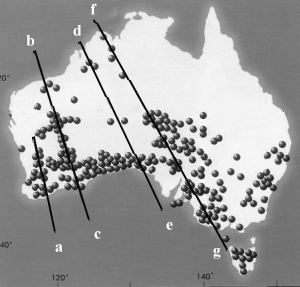
Bands of tektite concentration:
- a = Wheat Belt - West Australia
- b -c = Israelite Bay to Port Hedland with most patches along this line inthe Eastern Goldfields region of West Australia.
- f -g = From Tasmania through the well known regions of Port Campbell, Lake Torrens, Charlotte Waters to the new localities of Lake Argyle and King George River.
This is surely no coincidence. The other lines may also point to Indochina but at this stage I require more detailed information on localities of 'dense patches' for the Eastern Goldfields of West Australia rather than distribution of scattered tektites.
The area between c and e (the Nullarbor) had more scattered tektites inland than that suggested by the distribution map and it would be better to draw a map showing patches of a certain density as depicted by the South Australian one drawn by *McColl and Williams in their paper. There actually seems to be either a broader band or a few bands in West Australia. These bands are close to being parallel.
A similar pattern of bands was found in South East Asia, usually alternating with bands completely barren of tektites!

'Parent Body' Theory Revisited!
This theory was first proposed by *(5) E. W. Adams and R. Milton Huffaker from the space flight centre, Huntsville Alaska. It seems to be the only explanation for 'dense isolated patches'. It would explain the straight bands of australites and account for the differences seen between patches in distribution, size and form and chemical composition.
They made calculations of speed and angle of entry according to the amount of ablation seen on australites.
They found that the australite buttons would have had to enter the atmosphere at a very shallow entry angle adjacent to the skipping limit at a minimum speed of 7.7km/sec. They concluded that it would be impossible for any body originating from the earth , to have been ejected and re-enter at this angle and therefore dismissed a terrestrial origin as being impossible.
They calculated a minimum mass loss of 70% for buttons which required a very long-lasting re-entry flight.
The parent bodies entered at a shallow angle close to overshoot. Molten blobs are ablated off the parent bodies as they glanced (skipped) off the atmosphere in hypersonic flight. The blobs may have been 'bounced' back out of the atmosphere along with the parent body enabling them to cool and solidify before re-entering and ablating to form the typical australite shapes.
Maybe the parent bodies themselves eventually fell through the atmosphere disintegrating on mass into a shower of tektites. The only problem with this is the required initial solidification of the primary body tektites before secondary melting to form the aerodynamically shaped tektites. But it does account for the presence of low pressure bubbles containing atmospheric gases trapped in the tektites which give an altitude of about 40km for their formation .
Their calculations based on vapour pressure were revised by Chapman and Larson but the results were basically the same - the velocities neccessary for the ablation observed correspond with velocities coming from space.
There could be a maximum stable size of survival through the atmosphere for tektite material as australites over 100 grams are rare, the largest australite being 437 grams from Notting in South West Australia.
If there were slight differences in chemical composition of parent bodies it could alter the viscosity of the glass in flight and ultimately the size and shape of tektites leading to the differences seen in australites from different localities.
If the theory of 'parent bodies' is wrong, how did tight swarms of tektites travel thousands of kilometers and re-enter and fall in dense patches?
The only theory of terrestrial origin that is possible is that of meteorite or comet impact as a launch velocity of at least 6km/sec is required. Rocks thrown out by volcanic explosions can only reach 600m/sec.
Did the swarms or parent bodies originate from an impact event on the earth or from an extraterrestrial shower?
There are arguments for and against.
Arguments for terrestrial origin
- The lack of any evidence of cosmic ray interaction with tektite
glass seems to suggest only a short time in space and therefore they
could not have travelled far. A lunar origin has been dismissed
largely because of the impossibility of a 'focusing' mechanism to keep
the 'swarm' intact over such a distance and also on chemical analysis
of moon rocks being inconsistent with tektite material. The 'time in
space' precludes origin from further afield.
- There is a close similarity between tektite glass and terrestrial
sandstones.
- There seems to be a similar age for all tektites and microtektites
in the Australasian strewn field and the 'layered tektites' and
'splash form types' found in Asia suggest an impact occurred in this
region with the aerodynamically shaped australites actually being
ejected the furthest.
- Tektite glass is unlike any meteorite.
- An 'explosive' impact could theoretically form a vacuum enabling
rays of jetted material to travel back out of the atmosphere along the
path of the meteor. The 'rays' would account for the dense lines of
tektites .
Arguments against terrestrial origin
- The mechanism for ejection out of the atmosphere for a terrestrial
impact has not been discovered. The only way tektites could have
originated at an impact site and been 'jetted' out of the atmosphere
is if there was somehow a 'vacuum' created at the time of impact which
allowed escape of the tektite material. It would be impossible for
tektites to have left the atmosphere otherwise. An object the size of
a large tektite would be slowed down to a halt after only a few kms
flight at atmospheric pressure no matter how great its initial
velocity. The preponderance of spheres as primary bodies for
australites suggests a formation (possibly a condensing out) of molten
blobs in a vacuum which was not affected by other forces beside
surface tension. Trapped bubbles inside australites formed under low
pressures.
The problem with 'jetting' according to O'Keefe is that it would be difficult to see how a tektite could be first viscous enough to resist the stresses of acceleration and then be fluid enough to yield to surface tension before it cools.
- The very shallow entry angle and speed required for the ablation
seen on buttons would be difficult if not impossible for a terrestrial
origin.
- For the 'explosive' impact required there should be a vaporization
of both meteor and surface crust with a consequent mixing of
materials. Nickel - iron spherules have only been found in
Phillipinites and Dalat tektites and are abundant in true impact
glasses but are absent from australites.
- For the whole of the Australasian field to have been created by one
impact event it must have been a catastrophic event with global
effects. At an estimated age of 700,000 years, it happened in very
recent geological time yet no impact crater has been found. For an
impact big enough to throw enough debris out into the atmosphere to
account for the australasian field it would need to be larger than
Ireland (Lins).
- Microtektites have been found in oceanic cores associated with 3
tektite fields. Their ages correspond to the macrotektites but the
bottle-green microtektite composition is pyroxenitic. Pyroxenes are
not common rocks and for all three different microtektite fields to
contain them by chance is highly improbable.
- Although Muong Nong tektites are thought to have originated from
the melting of surface soils the soil in these regions today is very
different being mostly Fe2O3 and Al2O3 and is lateritic. Laterites
form by leaching over a very long period of time. Also, Muong Nongs
are regarded as having formed in situ yet localities are up to 900km
apart and up to 2400km if the Phillipine site is included - too wide a
field to be produced by even a comet!
- O'Keefe concluded that the instantaneous production of masses of
homogeneous and relatively bubble-free glass of low water content from
common soil and rocks, was not physically possible and that tektites
differed significantly from true impact glasses.
To quote O'Keefe:
We are thus forced to accept the conclusion which at first seems incredible, that tektites, despite their remarkable resemblance to terrestrial rocks, do not originate on the earth.'
We are still a long way from a complete answer.
Characteristics of Tektites
Tektites are still poorly understood. They are irregularly- and at times intricately-shaped nodules and blobs of a glassy substance. They have no crystal structure, and are therefore similar to obsidian, but are not associated with volcanic processes. Their chemistry is unique and somewhat unexplained. The leading theory concerning their origin is the "Meteorite Impact Theory". It is postulated that many odd events occur during a meteor's impact because of the tremendous heat and pressure produced. Tektites may be fused glass that formed during an impact of a meteor with layers of rock on the Earth's surface. Tektites occur in broad bands in specific localities in different parts of the world. These bands produce characteristically similar tektites and are sometimes loosely associated with meteorite craters or suspected craters. Could these fields represent splash material from an impact? Many believe so and this idea is gaining acceptance from many scientists. The odd and diverse chemistry of the tektites could be a result of unique meteorites hitting unique rock types with the combinations producing particular effects.
Some tektites, called Moldavites, are especially prized for their clarity and unique green color. Moldavites are found in a "splash field" centered around Moldavia in former Czechoslovakia and are believed to have come from a meteorite crater in Germany. Moldavites are sometimes cut as gemstones or put into jewelry as natural uncut pieces to show off their often eerie and beautifully intricate shapes.
Physical Characteristics:
- Color is black, green or colorless.
- Luster is vitreous to dull.
- Transparency: Gemmy tektites are transparent to translucent, but most are nearly opaque.
- Crystal System does not apply because tektites are amorphous.
- Habits are usually small nodules or splinters that vary from simple rounded shapes to very intricate natural carvings. Many have smooth, scarred, or pitted surfaces.
- cleavage is absent.
- Fracture is conchoidal.
- Hardness is 5 - 6.
- Specific Gravity is approximately 2.5 (somewhat light).
- Streak is white.
- Other Characteristics: Can sometimes be directly associated with meteorite impact craters.
- Notable Occurrences include Moldavia region of Eastern Europe; Thailand and southeast Asia; Australia and Georgia, USA.
- Best Field Indicators are color, odd shapes, localities and lack of cleavage or crystal faces.
References
Editorial note: several of theses links are no longer live...Web Sites
Guy Heinen homepage e-mail
The Meteorite Exchange homepage
Meteorite Central homepage
Books
Tektites by Ken McNamara and Alex Bevan
Tektites - witnesses of Cosmic Catastrophes by Guy Heinen
Tektites by Barnes and Barnes
Tektites and Their origin by J.A O'Keefe
Journals and magazines
Meteoritics & Planetary Science is the journal of the Meteoritical Society.
Geochimica et Cosmochimica Acta is the journal of the Geochemical Society and the Meteoritical Society.
A subscription to both journals is possible when joining the Meteoritical Society.
Meteoritical Society homepage
Meteoritics & Planetary Science e-mail homepage
Meteorite! e-mail homepage
Voyage! e-mail homepage
Papers
* (1) Journal of The Geological Society of Australia Vol. 18, Pt 4, pages 409-418, 1972.
*(2) R.O. Chalmers, E.P.Henderson and B. Mason 1976. Occurrence, distribution and age of Australian tektites.
Smithsonian Contributions to the Earth Science No 17 p46
*(3) Cleverly W. H.(1973) Australites from Menangina Pastoral Station, WA. Chemie der Erde 32 241-248
*(4) D.McColl, G. Williams. Nature Vol226, No 5241 pages 154-155
*(5) E. W. Adams and R. Milton Huffaker Aerodynamic analysis of the tektite problem Geochim. Cosmochim. Acta, 28 881-892
*(6) Alleged newly-fallen australite, You Yangs, Victoria. G. Baker. Geoch. et Cosm Acta 1964 Vol 28 995-997.
*(7) Note on an australite observed to fall in Western Australia. E.S. Simpson, 1935
*(8) A second australite observed to fall in Western Australia. E. Simpson 1939 Journal Royal Soc. of WA Vol XXV
*(9) Tektite Obsidian Glass from Space. Masako Shima, M. Hoada, M. Ebihara, Yayoi N. Miura, K. Nagao.(Nasa Astrophysics Data System)

